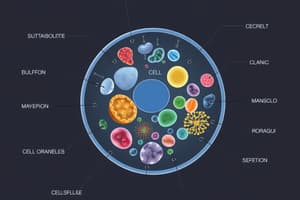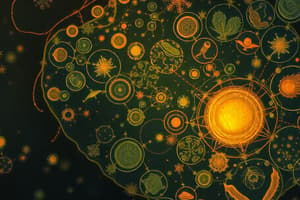Podcast
Questions and Answers
Which of the following is NOT a function of cells?
Which of the following is NOT a function of cells?
- Reproduction
- Photosynthesis (correct)
- Response to stimuli
- Metabolism
Tissues are made up of different types of cells working together to perform a specific function.
Tissues are made up of different types of cells working together to perform a specific function.
False (B)
What are the four main tissue types in animals?
What are the four main tissue types in animals?
Epithelial, connective, muscle, and nervous tissues.
The ________ is an organ responsible for pumping blood throughout the body.
The ________ is an organ responsible for pumping blood throughout the body.
What is the primary role of muscle tissue?
What is the primary role of muscle tissue?
Match the following organs with their primary functions:
Match the following organs with their primary functions:
Cell division is important for growth and repair of tissues.
Cell division is important for growth and repair of tissues.
Who were the main contributors in formulating the cell theory?
Who were the main contributors in formulating the cell theory?
Flashcards
What is the Cell Theory?
What is the Cell Theory?
All living organisms are composed of cells, which are the basic structural and functional units of life. Cells arise only from pre-existing cells.
What do cells do?
What do cells do?
Cells are the smallest unit of life and carry out all essential life functions. They metabolize, reproduce, and respond to stimuli.
What is metabolism?
What is metabolism?
Metabolism refers to all the chemical reactions that occur within a cell, including breaking down nutrients and building new molecules.
How do cells reproduce?
How do cells reproduce?
Signup and view all the flashcards
How do cells respond to their environment?
How do cells respond to their environment?
Signup and view all the flashcards
What are tissues?
What are tissues?
Signup and view all the flashcards
What are organs?
What are organs?
Signup and view all the flashcards
What are organ systems?
What are organ systems?
Signup and view all the flashcards
Study Notes
Cell Theory
- Cell theory is a fundamental concept in biology stating that all living organisms are composed of cells, cells are the basic units of structure and function in living organisms, and cells arise from pre-existing cells.
- The first description of cells was made by Robert Hooke in 1665.
- Anton van Leeuwenhoek observed single-celled organisms.
- Matthias Schleiden and Theodor Schwann formulated the cell theory in the mid-19th century.
- Rudolf Virchow completed the cell theory by adding the crucial component about cell genesis.
Cell Function
- Cells perform various functions necessary for life, including metabolism, reproduction, and response to stimuli.
- Metabolism encompasses all chemical reactions within a cell, including the breakdown and synthesis of molecules.
- Cells reproduce through cell division, ensuring growth and repair.
- Cells respond to internal and external stimuli, maintaining homeostasis.
- The specific functions vary greatly depending on the cell type (e.g., muscle cells contract, nerve cells transmit signals).
- Cells have specialized structures called organelles that perform specific tasks.
Tissues
- Tissues are groups of similar cells that work together to perform a specific function.
- Four main tissue types in animals: epithelial, connective, muscle, and nervous tissues.
- Epithelial tissue covers surfaces, lines body cavities, and forms glands.
- Connective tissue supports and connects other tissues, including bone, cartilage, and blood.
- Muscle tissue allows movement.
- Nervous tissue transmits nerve impulses.
Organs
- Organs are structures composed of two or more tissue types that work together to perform a specific function.
- Organs are highly specialized for their roles.
- Examples include the heart, lungs, liver, stomach, brain and kidneys.
- Organs work in coordination within organ systems to maintain the overall health and function of an organism.
- Organs have specialized regions and structures in order to facilitate the functions they carry out.
- Organs can be comprised of several types of tissues in varying amounts. For example, the stomach comprises layers of smooth muscle tissue for digestion and epithelial tissue lining the stomach.
- Specialized cells within organs work together with supporting tissues such as connective and other cell types contributing to organ function.
Studying That Suits You
Use AI to generate personalized quizzes and flashcards to suit your learning preferences.




